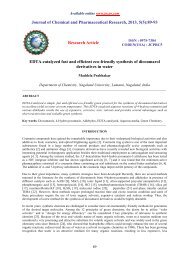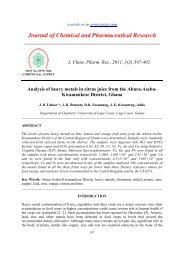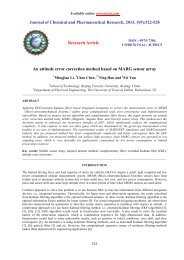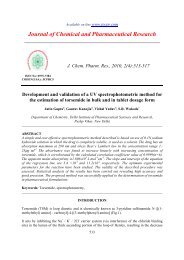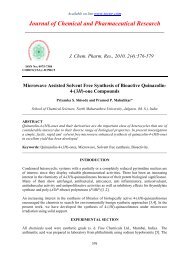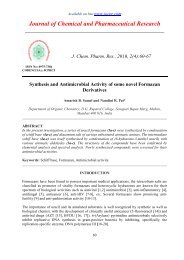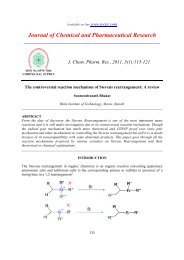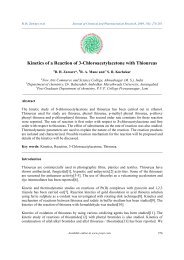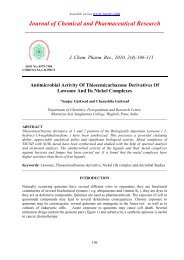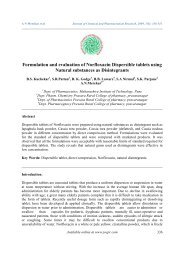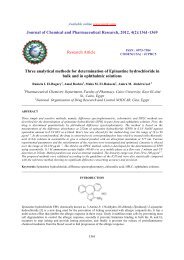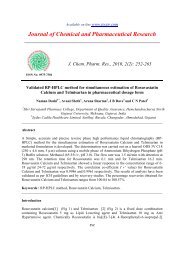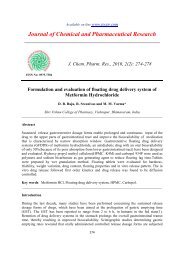Effect of Zinc and Sulphur on herb, oil yield and quality - Journal of ...
Effect of Zinc and Sulphur on herb, oil yield and quality - Journal of ...
Effect of Zinc and Sulphur on herb, oil yield and quality - Journal of ...
Create successful ePaper yourself
Turn your PDF publications into a flip-book with our unique Google optimized e-Paper software.
Ajay Kumar et al J. Chem. Pharm. Res., 2010, 2(4):642-648_____________________________________________________________________________MATERIALS AND METHODSThe field experiment was c<strong>on</strong>ducted at the Crop Research Center, G.B.P.U.A&T Pantnagarduring the years Feb-Aug in 1999 <str<strong>on</strong>g>and</str<strong>on</strong>g> 2000 respectively. The experimental field was silty clayloam in texture having the pH <str<strong>on</strong>g>of</str<strong>on</strong>g> 7.2, medium in available nutrients viz. N (262 kg/ha), P (18.23kg/ha), K (165.2 kg/ha), S (16.90 kg/ha) <str<strong>on</strong>g>and</str<strong>on</strong>g> Zn (1.88 kg/ha). The C.E.C <str<strong>on</strong>g>of</str<strong>on</strong>g> the s<strong>oil</strong> was 26.5centimole/kg <str<strong>on</strong>g>and</str<strong>on</strong>g> Organic carb<strong>on</strong> c<strong>on</strong>tent was 0.55%. The experiment was laid out inR<str<strong>on</strong>g>and</str<strong>on</strong>g>omized Block Design having three levels <str<strong>on</strong>g>of</str<strong>on</strong>g> N.P.K viz. 70%<str<strong>on</strong>g>of</str<strong>on</strong>g> the recommended N.P.K,recommended N.P.K (150:60:40) <str<strong>on</strong>g>and</str<strong>on</strong>g> 130 % <str<strong>on</strong>g>of</str<strong>on</strong>g> recommended N.P.K. al<strong>on</strong>g with sulphur(20kg/ha), zinc (5.625 kg/ha applied through ZnSO 4 .7H 2 O @ 25 kg/ha) <str<strong>on</strong>g>and</str<strong>on</strong>g> zinc plus sulphur (@25 kg ZnSO 4 .7H 2 O / ha <str<strong>on</strong>g>and</str<strong>on</strong>g> 20 kg S/ha) including <strong>on</strong>e c<strong>on</strong>trol (13 treatments). Nitrogen wasapplied in 4 equal split doses at planting, 50 days after planting, just after first harvest, <str<strong>on</strong>g>and</str<strong>on</strong>g> 35day after first harvest. The whole amount <str<strong>on</strong>g>of</str<strong>on</strong>g> P, K, S, <str<strong>on</strong>g>and</str<strong>on</strong>g> Zn was applied as basal before theplanting. The amount <str<strong>on</strong>g>of</str<strong>on</strong>g> sulphur supplied by Zn SO 4 was corrected by applying uniform dose <str<strong>on</strong>g>of</str<strong>on</strong>g>gypsum to all the plots including c<strong>on</strong>trol. The suckers <str<strong>on</strong>g>of</str<strong>on</strong>g> menthol mint were planted <strong>on</strong> Feb th 5<str<strong>on</strong>g>and</str<strong>on</strong>g> 10 th during 1999 <str<strong>on</strong>g>and</str<strong>on</strong>g> 2000 in end to end fashi<strong>on</strong> 4 cm deep in furrows opened at 45 cm apart.The harvesting was d<strong>on</strong>e twice at 112 days <str<strong>on</strong>g>and</str<strong>on</strong>g> 172 days after planting during both the years.The <strong>oil</strong> in the fresh <strong>herb</strong>age was extracted through hydro stem distillati<strong>on</strong> using Clevenger’sapparatus. The chemical compositi<strong>on</strong> <str<strong>on</strong>g>of</str<strong>on</strong>g> <strong>oil</strong> samples was estimated by using Nuc<strong>on</strong> 5700 (GC)with capillary injector, Capillary column <str<strong>on</strong>g>and</str<strong>on</strong>g> thermal c<strong>on</strong>ductivity detector.RESULTS AND DISCUSSIONGrowth <str<strong>on</strong>g>and</str<strong>on</strong>g> YieldApplicati<strong>on</strong> <str<strong>on</strong>g>of</str<strong>on</strong>g> sulphur, zinc <str<strong>on</strong>g>and</str<strong>on</strong>g> zinc + sulphur increased plant height, leaf area index (LAI) <str<strong>on</strong>g>and</str<strong>on</strong>g>leaf to stem ratio with all three NPK levels during both harvest in the years 1999 <str<strong>on</strong>g>and</str<strong>on</strong>g> 2000. Thehighest plant height, LAI <str<strong>on</strong>g>and</str<strong>on</strong>g> leaf to stem ratio were observed in treatment S+Zn with 130 % <str<strong>on</strong>g>of</str<strong>on</strong>g>recommended NPK level which was significantly higher as compared to 70 % <str<strong>on</strong>g>of</str<strong>on</strong>g> recommendedNPK levels with S, Zn, <str<strong>on</strong>g>and</str<strong>on</strong>g> Zn+S ( Table-1).<str<strong>on</strong>g>Zinc</str<strong>on</strong>g> has been found to involve in photosynthesis <str<strong>on</strong>g>and</str<strong>on</strong>g> saccharide metabolism, <str<strong>on</strong>g>and</str<strong>on</strong>g> proteinsynthesis. It has been reported (9), that zinc deficiency retards the activity <str<strong>on</strong>g>of</str<strong>on</strong>g> photosyntheticenzymes such as carb<strong>on</strong>ic anhydrase, ribulose1-5bisphosphate carboxylase/oxygenase, <str<strong>on</strong>g>and</str<strong>on</strong>g>fructose 1-6 bisphosphate. Whereas sulfur, deficiency causes a str<strong>on</strong>g shift in the balancebetween the soluble <str<strong>on</strong>g>and</str<strong>on</strong>g> insoluble nitrogen towards the soluble fracti<strong>on</strong> (mainly glutamine <str<strong>on</strong>g>and</str<strong>on</strong>g>asparagine). Sulfur deficiency is characterized by arginine <str<strong>on</strong>g>and</str<strong>on</strong>g> amide accumulati<strong>on</strong>, as proteinsynthesis is arrested (4). Thus due to better availability <str<strong>on</strong>g>of</str<strong>on</strong>g> zinc <str<strong>on</strong>g>and</str<strong>on</strong>g> sulfur, the activities <str<strong>on</strong>g>of</str<strong>on</strong>g>various enzyme were enhanced causing more protein synthesis, this led to increase in variousgrowth parameters such as plant height, leaf area index, <str<strong>on</strong>g>and</str<strong>on</strong>g> leaf to stem ratio, ultimatelyresulting in higher <strong>herb</strong>age <strong>yield</strong>.The <strong>herb</strong>age <str<strong>on</strong>g>and</str<strong>on</strong>g> essential <strong>oil</strong> <strong>yield</strong> were significantly influenced by NPK levels al<strong>on</strong>e or withzinc, sulfur, or zinc + sulfur ( Table-2). The higher crop growth with applicati<strong>on</strong> <str<strong>on</strong>g>of</str<strong>on</strong>g> 130% <str<strong>on</strong>g>of</str<strong>on</strong>g>NPK +Zn+S resulted in higher <strong>herb</strong>age <strong>yield</strong> at first harvest (265.2 <str<strong>on</strong>g>and</str<strong>on</strong>g> 248.7 q/ha) <str<strong>on</strong>g>and</str<strong>on</strong>g> atsec<strong>on</strong>d harvest (379.4 <str<strong>on</strong>g>and</str<strong>on</strong>g> 376.7 q/ha) over the other NPK levels, al<strong>on</strong>e or with zinc, sulfur orzinc+sulfur in the year 1999 <str<strong>on</strong>g>and</str<strong>on</strong>g> 2000 respectively. This increase in <strong>herb</strong>age <strong>yield</strong> was due toincrease in various growth parameters during both the years. The increased supply <str<strong>on</strong>g>of</str<strong>on</strong>g> nutrients inthis treatment enhanced leaf area for sufficient photosynthetic surface which in turn facilitatedthe crop for more vegetative growth <str<strong>on</strong>g>and</str<strong>on</strong>g> sec<strong>on</strong>dary metabolites accumulati<strong>on</strong>. Similar increase in<strong>herb</strong>age <strong>yield</strong> <str<strong>on</strong>g>of</str<strong>on</strong>g> Mentha arvensis L. due to applicati<strong>on</strong> <str<strong>on</strong>g>of</str<strong>on</strong>g> 80-140 kg N, 40-60 kg P 2 O 5 <str<strong>on</strong>g>and</str<strong>on</strong>g> 20-40643



